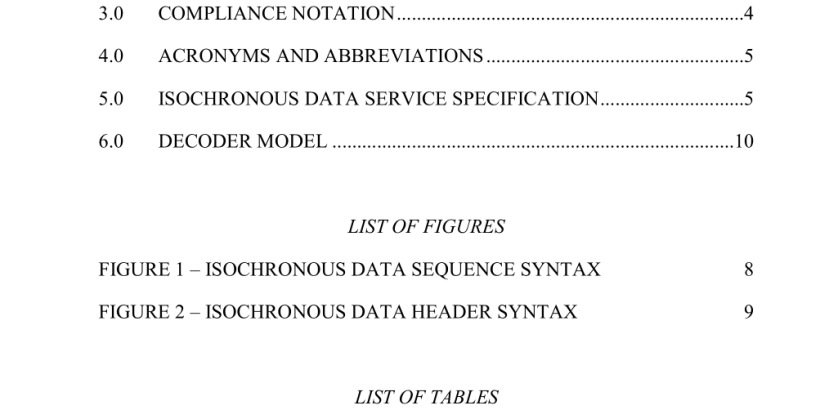ANSI SCTE 19-2018 pdf download.Methods for Isochronous Data Services Transport
2.1 The following documents contain provisions, which, through reference in this text, constitute provisions of the standard. At the time of Subcommittee approval, the editions indicated were valid. All standards are subject to revision; and while parties to any agreement based on this standard are encouraged to investigate the possibility of applying the most recent editions of the documents listed below, they are reminded that newer editions of those documents may not be compatible with the referenced version.
3.0 COMPLIANCE NOTATION
This word or the adjective“REQUIRED” means that the item is an absolute requirement of this specification. This phrase means that the item is an absolute prohibition of this specification. This word or the adjective“RECOMMENDED” means that there may exist valid reasons in particular circumstances to ignore this item, but the full implications should be understood and the case carefully weighted before choosing a different course. This phrase means that there may exist valid reasons in particular circumstances when the listed behavior is acceptable or even useful, but the full implications should be understood and the case carefully weighed before implementing any behavior described with this label. This word or the adjective“OPTIONAL”means that this item is truly optional. One vendor may choose to include the item because a particular marketplace requires it or because it enhances the product, for example; another vendor may omit the same item.
Each data item is described by its name, its length in bits, and a mnemonic for its type and order of transmission. The action caused by a decoded data element in a bitstream depends on the value of that data element and on data elements previously decoded. The constructs in normal type in the table are used to express the conditions when data elements are present.
If the condition is true, then the group of data elements occurs next in the data stream. This repeats until the condition is not true. The data element always occurs at least once. The data element is repeated until the condition is not true. If the condition is true, then the first group of data elements occurs next in the data stream. If the condition is not true, then the second group of data elements occurs next in the data stream. The group of data elements occurs n times. Conditional constructs within the group of data elements may depend on the value of the loop control variable i, which is set to zero for the first occurrence, incremented to one for the second occurrence, and so forth. Explanatory comment that may be deleted entirely without in any way altering the syntax.
5.3 Isochronous Data Bitstream Syntax
Isochronous data is carried as a Packetized Elementary Stream (PES). The PES payload, which follows the PES header specified by MPEG-2, begins with an isochronous data header, which is followed by isochronous data access units. The isochronous data header is present even when the PES header does not include a Presentation Time Stamp (PTS). Each isochronous data access unit is 16 bits (2 bytes; 1 word). Additionally, isochronous data access units are aligned with the PES syntax in that the first byte of the isochronous data header immediately follows the last byte of the PES header. Finally, isochronous data access units are aligned with transport packet payloads such that the first payload byte of an isochronous data transport packet is the first byte of an isochronous data access unit (following any adaptation, PES header, and isochronous data header fields), and the last byte of an isochronous data transport packet is the last byte of an isochronous data access unit. Stuffing bytes in the adaptation or PES header may be included to accomplish this. The syntax of isochronous data is as specified in the following paragraphs.ANSI SCTE 19-2018 pdf download
